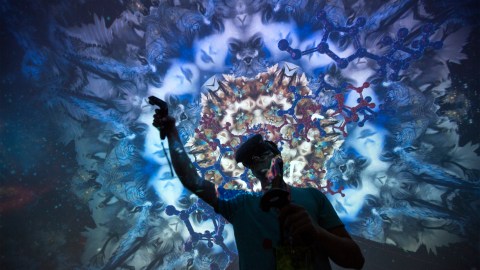What would it take to create a fully immersive virtual reality?

Photo credit: David McNew / Getty Images
- Immersion would consist of a complete perception of existing in another world.
- This idea has been the backbone of numerous stories and would be akin to The Matrix world.
- Our current VR technology is nowhere near close to giving us this science fiction experience.
Immersive virtual reality is the theoretical holy grail of future technologies. A fully immersive VR world would be able to encompass every single sense and interact directly with the brain and nervous system. In some sense it could even be a replacement for consensus reality. Eat your heart out, Descartes. There have been countless iterations of this idea through both fictional and philosophical works.
The path towards realizing this incredible technology is paved with an enormous amount of what-ifs and wild speculative technological capabilities. But pondering this idea is half the fun. Here’s what it would take to create a fully immersive virtual world.
The varied representations of this technology share many commonalities. People connecting to the system are often booted in through some kind of central nervous system jack and then made unconscious of their physical body and surrounding environment.
We interact with the world through our senses, which are nerve impulses in different degrees of fidelity. A fully virtual world would be able to reproduce all of our senses and more fantastical feelings, thoughts and more in a completely artificial environment. The possibilities for experience are endless.
For those familiar with William Gibson’s novel Neuromancer, the Cyberdeck brings to mind an example of a fully immersive VR landscape. At one point in the novel, the protagonist Case remarks about cyberspace:
“Cyberspace. A consensual hallucination experienced daily by billions of legitimate operators, in every nation, by children being taught mathematical concepts… A graphic representation of data abstracted from the banks of every computer in the human system. Unthinkable complexity. Lines of light ranged in the nonspace of the mind, clusters and constellations of data. Like city lights, receding…”
Whether it’s a kind of headset, nervous system jacked-in wire, humans suspended in some eternal vat or other disembodied consciousness, this science fiction technology is far out and eons ahead of anything we’re now capable of experiencing with our limited VR & AR glasses.
Is this hat conscious? | Ben Goertzel on consciousness, panpsychism, and AGI | Big Thinkwww.youtube.com
It’s difficult to get a grasp on where to even begin development on this technology as it is an intersection between computing, neuroscience, and biology just to start. Take for example what would be needed in terms of a feedback system between the user and computer. The brain-to-machine bandwidth would require incredible feats of computing tech to pass through all that information.
In terms of history, the computer age is in its absolute infancy. Biological systems have been cranking at it for 3.5 billion years. The convergence of these two is going to take a lot more knowledge of all their intricate workings. Right now we lack any uniform insight into what human consciousness is and the interworking relationship between the brain and nervous system.
We’ve done a great job learning and understanding how individual processes work, but as a whole we don’t know much. Aside from some limited brain to speech technologies and other assorted brain and nervous system experiments, scientists haven’t had much luck getting a controlling grasp on the systems of control even when it comes to experimenting on non-human life forms.
For example, scientists have been able to modify the behavior of a certain cockroach species by connecting wires into its antennae and shifting its movement a little bit. Yet as a relatively simple animal, our understanding of its control systems still lags behind.
The biggest barrier to understanding and synthesizing all of this into one uniform technology is the disparate paths that these different sciences take. An upheaval and disruption in computing a neuroscience revolution and the will to merge all of this together is needed.
While this fully immersive virtual world still exists on the peripheries of our dreams, we can contribute to the technology already in place. Slap on a pair of VR glasses today and you’ll be amazed at how far we’ve come in the past few decades. Although the current reality is pessimistic about the near-term possibilities of full VR immersion, don’t despair. The ever beating drum of scientific progress is elusive but always near.
Are We Living in a Massive Computer Program? Or a Simulation? | Joscha Bach | Big Thinkwww.youtube.com





